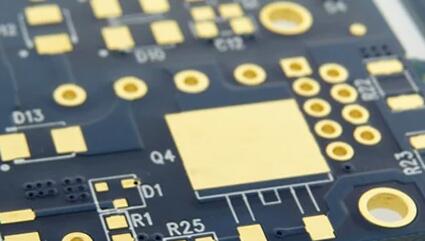Gold plating is a type of PCB surface treatment, also known as nickel plating gold. In the PCB manufacturing process, gold plating is achieved by depositing a layer of gold on the barrier layer of nickel through electroplating. Gold plating can be divided into "hard gold plating" and "soft gold plating".

Gold plated PCB board
Gold-plated PCB boards are made by electroplating a layer of gold on the surface of PCB circuit board pads, which are made of hard gold. The principle is to dissolve nickel and gold in a chemical solution, immerse the circuit board in an electroplating cylinder, and connect an electric current to generate a nickel-gold coating on the copper foil of the circuit board.
The Role of Gold Plating
1. The two functions of gold plating are wear resistance and corrosion resistance. Parts with sockets and gold fingers need to be gold plated, and areas in contact with conductive rubber need to be gold plated. Circuit boards working in highly corrosive environments require the use of gold plated circuit boards. The circuit board is plated with gold to prevent oxidation, protecting the bottom layer of nickel and copper. The gold is wear-resistant and has good reliability.
2. The advantages of gold-plated PCB boards are strong conductivity, good oxidation resistance, and long service life. The coating is dense and relatively wear-resistant, and is generally used in welding and socket applications. The gold plating process is widely used in circuit board components such as solder pads, gold fingers, connector shrapnel, and other positions. The most widely used hand circuit boards we use are mostly gold-plated boards.
3. Gold plating has low contact resistance, good conductivity, easy welding, strong corrosion resistance, and certain wear resistance (referring to hard gold), making it widely used in precision instruments, printed circuit boards, integrated circuits, tube shells, electrical contacts, and other fields.
The difference between soft gold and hard gold
In the PCB gold plating process, hard gold plating is also known as an electroplating alloy. It has been alloyed with other elements to make it harder, while soft gold plating is pure gold.
The application of electroplated gold in PCB manufacturing. Hard gold plating is suitable for areas such as gold fingers and keyboards that require friction. Soft gold is commonly used for aluminum or gold wiring on COB (on board chips).
The Difference between PCB Gold Deposition and Plating
1. Process principle
PCB gold deposition is a process of depositing metal ions on the surface of a circuit board. During this process, the circuit board is immersed in a solution containing gold salts and reducing agents, and gold ions are reduced to metal and deposited on the surface of the circuit board. Gold plating is the process of immersing a circuit board in a solution containing gold salts, and then applying electricity to deposit gold ions on the surface of the circuit board.
2. Metal thickness
The metal thickness of PCB sinking gold and plating gold is different. Gold deposition can form a relatively thick metal layer, typically reaching 2-5 microns. The gold plated metal layer is relatively-thin, usually only around 0.5-1.5 microns.
3. Metal color
The metal colors of PCB sinking gold and gilding are also different. The metal color of heavy gold is golden yellow, while the metal color of gilding is light yellow.
4. Surface flatness
The surface flatness of PCB sinking gold and gold plating is also different. The surface of the sinking gold is relatively flat, which can maintain high-quality welding and contract performance. The surface of gold plating is relatively rough, which is prone to welding and contact problems.
5. Cost
The cost of PCB gold deposition and plating is also different. The cost of sinking gold is relatively high because it requires more chemical reagents and a longer processing time. The cost of gold plating is relatively low because of its short processing time and simple operation.
Process flow of PCB gold plating
Gold plating has low contact resistance, good conductivity, easy welding, strong corrosion resistance, and certain wear resistance (referring to hard gold), making it widely used in precision instruments, printed circuit boards, integrated circuits, tube shells, electrical contacts, and other fields.
1. Surface treatment: Clean the surface of the PCB to remove oil stains, burrs, oxide layers, etc.
2. Electroplating: Place the PCB into the electroplating bath and add the plating solution. The electroplating solution contains a reducing agent, which can reduce the gold atoms on the PCB surface into metal ions and deposit them on the PCB surface.
3. Water washing: After electroplating, there will be a layer of metal deposition on the surface of the PCB, which needs to be cleaned with water.
4. Drying: Place the PCB in a drying oven and dry with water.
5. Adhesive application: Apply a layer of conductive adhesive to the surface of the PCB to ensure good contact between the PCB and other devices.
6. Recycling: Remove the PCB from the adhesive tape and place it in the recycling bin.
The gold-plated PCB board can play a protective role, and the gold-plated layer can protect the circuit board from oxidation, corrosion, and other effects, increasing the service life of the circuit board. Metals themselves have good conductivity, which can improve the conductivity of PCBs and reduce line impedance.